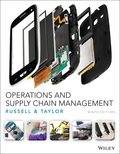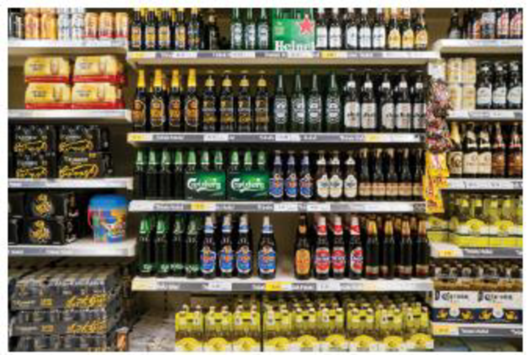
Concept explainers
Supply and Demand in the Spirits Industry
A beverage retailer in the spirits industry often sells products from around the world, each with its own unique supply chain. Beverages for mass consumption (beers and most wines) have a limited shelf life; fine wines and spirits have an extended life but, at a $100 to $3000 per bottle, can tie up needed cash in inventory. Stocking the latest trendy or seasonal beverage can be difficult because of lengthy lead times and the sheer number of SKUs (stock keeping units) available (see photo). A shipment of wine from Argentina, for example, takes an average of 60 days to arrive stateside. Craft beers may be produced in limited quantities and are marketed for specific seasons, so a single order placed a year in advance may be the only opportunity to guarantee supply.
Weight is another problem in the spirits supply chain. A typical 20-foot shipping container packed with bottled product will hit weight restrictions long before reaching FTL (full truck load) by volume. And different countries have different weight restrictions. Several solutions have been proposed. One is transporting mixed loads by partnering with a company whose product follows a similar geographic path but is lightweight. Another is transporting the product in bulk for the longest portion of the trip and bottling it nearer to major markets. Flexible plastic containers (called KN blue tanks) designed to fill a twenty-foot shipping container are more commonly used by producers in Australia and South America. Multiple bottling facilities, however, can add cost, and errors in estimating demand can mean a product needs to be transported further than anticipated to find a receptive market. Finally, the finished product itself can be sold in bags, boxes, or pouches instead of bottles. Astro pouches with colorful designs have become quite popular for some types of alcoholic beverages.
Climate controlled transport is expensive, too, especially for ocean routes; so much so that shippers of wine and beer to northern markets may travel to less accessible warm weather ports and then use heated trucks for transport to final destinations in colder climes. Some companies only ship product during the more temperate months of the year, further restricting supply.
Fine wines present their own special problems. Most wines travel from vineyard to producer to distributor to retailer within a year. However, fine wines may not be ready to drink for 10 years and may have a shelf life of 50 years. Ownership can change many times from production to consumption, and inventory must be carefully stored. Transporting these wines often or over long distances can damage them and expose the owner to fraud and theft. A pallet of Chateau Lafite-Rothschild Bordeaux, for example, may be valued at half a million dollars. So a new industry has emerged that keeps fine wines in climate controlled storage and transfers ownership (in a database), instead of product, when sales are made.

Faiz Zaki/Shutterstock
How would you handle demand
Want to see the full answer?
Check out a sample textbook solution
Chapter 14 Solutions
Operations and Supply Chain Management 9th edition
Additional Business Textbook Solutions
Corporate Finance (4th Edition) (Pearson Series in Finance) - Standalone book
Horngren's Cost Accounting: A Managerial Emphasis (16th Edition)
Financial Accounting, Student Value Edition (5th Edition)
Gitman: Principl Manageri Finance_15 (15th Edition) (What's New in Finance)
Intermediate Accounting (2nd Edition)
Principles of Operations Management: Sustainability and Supply Chain Management (10th Edition)
- 4. Based on the data provided in Table 2.5, what is the flow rate of callers from 8:00 a.m. to 8:20 a.m.? TABLE 2.5 Time Stamps of the Eight Callers Who Called from 8:00 a.m. to 8:20 a.m. to the Reservation Desk of a Ferry Service Caller Time In Time Out 1 8:01 8:05 2 3 4 5 6 8:02 8:07 8:06 8:08 8:09 8:12 8:10 8:15 8:12 8:20 7 8:16 8:19 8 8:17 8:19 5. Based on the data provided in Table 2.5, what is the flow time of callers from 8:00 a.m. to 8:20 a.m.? 6. Based on the data provided in Table 2.6, what is the flow rate of customers from 9:00 a.m. to 10:00 a.m.? TABLE 2.6 Time Stamps of 10 Customers Who Visited a Local Bank Branch from 9:00 a.m. to 10:00 a.m. Customer 1 2 3 4 5 6 7 8 9 10 Time In Time Out 9:01 9:07 9:06 9:21 9:08 9:20 9:14 9:19 9:20 9:28 9:26 9:33 9:31 9:39 9:40 9:46 9:44 9:59 9:53 9:57 7. Based on the data provided in Table 2.6, what is the flow time of customers from 9:00 a.m. to 10:00 a.m.?arrow_forwardHow is Little’s Law currently used in today’s supply chains? Provide an example of where it is used.arrow_forwardHow would you Briefly state your views on music for a Christian school interview?arrow_forward
- 3) Rane Brake Linings manufactures brake pads in a process focused facility; the fixed costs are nine thousand dollars per year, the variable cost is fifty dollars per brake pad, each brake pad sells for two hundred dollars. a) Calculate the breakeven point (in units) for this operation. b) Calculate the breakeven point (in $) for this operation. c) Calculate the profit/loss on a demand of two hundred brake pads per year. Note: You could work out the problem by hand or use excel; in chapter 5, section 5.11 of the Stevenson text, evaluating alternatives (cost volume analysis) is covered with examples; chapter 5 Stevenson lecture power point slides 34 to 44 (chapter 5 lecture: 29.49 mins to 38.87 mins) cover cost volume analysis with examples.arrow_forward1. For the purpose of process analysis, which of the following measures would beconsidered an appropriate flow unit for analyzing the operation of a coffee shop?Instructions: You may select more than one answer. a. Square footage of the store b. Number of employees working each week c. Number of hours the store is open each week d. Number of customers served each weekarrow_forwardLO2-1 1. From the perspective of process analysis, which of the following could be appropriate flow units for a hardware store? a. Number of workers b. Number of cash registers c. Number of customers d. Number of suppliers page 37 2. Over the course of a month, which of the following is most likely to describe an appropriate flow unit for a process analysis of a hospital? a. The number of physicians b. The number of beds c. The square footage of the building d. The number of patients LO2-2 3. At a cruise ship terminal, each day on average 1000 passengers embark on ships. On average, passengers spend 5 days on their cruise before returning to this terminal. If the flow unit is a passenger, then what are the flow rate and flow time of this process? 4. It is election day and 1800 voters vote in their precinct’s library during the 10 hours the polls are open. On average, there are 15 voters in the library and they spend on average 5 minutes in the library to complete their voting. What is…arrow_forward
- What do you feel is the most effective way to communicate with families? Describe how you have used this/these technique(s).arrow_forwardPP.52 A manufacturer of solid state drives (SSDs) has projected the next six months of demand to be as shown the table below: Supply/Demand Info Beginning Jan Feb Mar Apr May Jun Forecast (demand) 53,800 53,400 51,000 63,800 49,200 59,000 Regular production Overtime production Subcontract production Ending inventory 4,000 Hired employees Fired employees Total employees 190 Cost variables are as follows: Cost Variables Labor cost/hour $16 Overtime cost/unit $39 Subcontracting cost/unit $35 Holding cost/unit/month $14 Hiring cost/employee $3,100 Firing cost/employee $5,500 Here is some additional relevant (capacity) information: Capacity Information Total labor hours/SSD 4 Regular production units/employee/month 200…arrow_forwardDiscuss how a human resource professional can better gain the confidence of senior management and, thereby, become a key participant/player in the organization’s future.arrow_forward
- PP.63 Jupiter, a large candy company, is having great success with its "Swan" family of candy bars. Due to a number of factors they like to plan their production at least six months into the future. The table below contains their demand projections (in tons) for April through September: Supply/Demand Info Beginning Apr May Jun Jul Aug Sep Predicted Sales 45,500 45,100 51,900 52,800 47,900 47,200 Regular production Overtime production Subcontract production Ending inventory 14,400 Hired employees Fired employees Total employees 423 Cost variables are as follows: Cost Variables Labor cost/hour $13 Overtime cost/ton $30 Subcontracting cost/ton $28 Holding cost/ton/month $14 Hiring cost/employee $3,700 Firing cost/employee $5,800 Here is some additional…arrow_forwardWhat are the responsibilities and duties of a consultant for a local company who is considering expanding its operations to international markets? How can a local Agriculture and Food Processing company successfully enter international markets?arrow_forwardWhat is an example of how someone would explain how their past personal and professional experience makes you a quality candidate for a teaching position at an Elementary School as a K-6 Teacher?arrow_forward
 Purchasing and Supply Chain ManagementOperations ManagementISBN:9781285869681Author:Robert M. Monczka, Robert B. Handfield, Larry C. Giunipero, James L. PattersonPublisher:Cengage Learning
Purchasing and Supply Chain ManagementOperations ManagementISBN:9781285869681Author:Robert M. Monczka, Robert B. Handfield, Larry C. Giunipero, James L. PattersonPublisher:Cengage Learning Contemporary MarketingMarketingISBN:9780357033777Author:Louis E. Boone, David L. KurtzPublisher:Cengage Learning
Contemporary MarketingMarketingISBN:9780357033777Author:Louis E. Boone, David L. KurtzPublisher:Cengage Learning Practical Management ScienceOperations ManagementISBN:9781337406659Author:WINSTON, Wayne L.Publisher:Cengage,MarketingMarketingISBN:9780357033791Author:Pride, William MPublisher:South Western Educational Publishing
Practical Management ScienceOperations ManagementISBN:9781337406659Author:WINSTON, Wayne L.Publisher:Cengage,MarketingMarketingISBN:9780357033791Author:Pride, William MPublisher:South Western Educational Publishing




